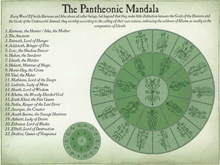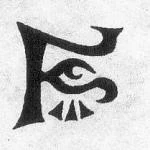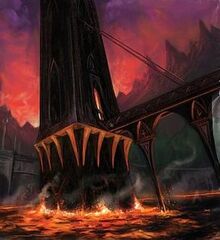
The High Elves of Ulthuan, while they do worship most of the elven pantheon, they mostly worship the Cadai, the gods of the heavens. These gods represent all the virtues and fundamental aspects of the elven people. They are led by the elven god Asuryan the Creator.
Overview
Worship

The Cadai tend to represent productive and fundamental aspects of Elven society such as crafting and smithing, motherhood, farming or hunting. The Cadai are openly worshipped and revered by the High Elves and by the Wood Elves, with large temples and shrines as well as clergy and devotees who publicly profess their faith. The High Elves seem to revere Asuryan, The Creator most highly, while the Wood Elves assign equally high reverence to Kurnous, the Hunter and Isha, The Mother. The Dark Elves seem to mostly ignore the Cadai.
Asuryon, the Creator

The symbol of the Phoenix, accompanied by the rune Asur
Asuryan, the Creator is the greatest and oldest of all the Elf gods. He is lord of the Cadai, the Gods of the heavens. According to the High Elves he has been shaping their destiny according to his plan since the dawn of time. When a quarrel breaks out or there is a disagreement between the gods in heaven, his is the final say and the other gods submit to his judgement. From his diamond throne Asuryan observes the world, draped in a cloak of lustrous white feathers, bearing a sceptre and wearing a mask which is half white and half black. Asuryan can take the form of a Phoenix or a Great Eagle when he chooses, and he is sometimes known as the Phoenix King to many High Elves, despite the ruler of Ulthuan sharing the same name.
The most common of Asuryan's symbols is a stylised pyramid with a phoenix in the centre spreading its huge wings. At the tip of the pyramid is portrayed the eternal flame as a sun shining rays of light. The chief temple to Asuryan is the Shrine of Asuryan on the Isle of Flame in the Inner Sea north of Lothern. It is here that the new Phoenix King is tested before being crowned by passing through the ever-burning flame at the heart of the shrine.
Isha, the Mother

The symbol of isha
Isha is the Elven Goddess of harvest and of natural bounty, mother of the earth and bringer of fertility. It was she who taught the Elves the skills of agriculture and how to care for the land in which they lived. With Isha's blessing the province of Avelorn remains free of winter's touch. Her husband is Kurnous, the God of the Hunt and she is the daughter of Asuryan and Lileath. She is a merciful god who sends aid to those most in need of it.
Isha is commonly portrayed as a gloriously beautiful elf maiden full of life, with long golden tresses flowing around her. Her symbol is an eye shedding a tear, which represents the tears Isha sheds for her mortal children, for although Elves are very long lived they are not immortal and must someday die. She is worshipped across Ulthuan, but particuarly in Avelorn where farmers give offerings to her temples in the hope of a good harvest. She is also considered one of the chief deities of the Wood Elves due to her connection to nature and her marriage to Kurnous.
The High Elves consider the Everqueen to be the symbol of and most beloved of Isha, while the Wood Elves believe that honour belongs to their queen Ariel. This is a source of contention between the races.
Kurnous, the Hunter

An Avatar of Kurnous
Kurnous is the Elven God of the Hunt and Lord of Beasts, he is the spirit of untouched wilderness. Although he is said to have the ability to take the form of any forest creature at will, he is normally portrayed as a figure over ten foot tall, with an Elven body but the head and tail of a stag. Kurnous is the husband of Isha, and he is the ultimate hunter. His horn announces the Wild Hunt and calls his pack of hunting dogs to his side as he passes silently among the trees.
The Elves of Avelorn and the citizens of Ellyrion worship Kurnous as their primary god. By never killing more than they must, hunters prove their loyalty to Kurnous. His affinity with the forest and wooded places holds a special significance with Wood Elves, and his living avatar is Orion, King of Athel Loren. Kurnous' holy places are deep in the forest, special clearings which are recognisable only to those who worship him.
Kurnous is also said to have a connection to Taal, the god of nature in the Old World. They are both represented by a long-antlered stag's head.
Hoeth, Lord of Wisdom
Hoeth, the Lord of Wisdom and Knowledge, is the Elven god of learning and sorcery. Although one of the Elven pantheon and held in esteem by all of the High Elves, Hoeth does not have much of a priesthood nor an organized system of churches in Ulthuan, save at the White Tower of Hoeth. Yet all of the scholars, teachers, mages - all who seek truth and understanding are his servants in the world.
The center of Hoeth's worship is the White Tower, raised at the order of the Scholar King Bel-Korhandis where mages go to learn the art of High Magic. The White Tower is guarded by the Swordmasters of Hoeth, an ancient order of ascetic warrior-monks who stand guardian over the Tower and the scholars who dwell within. These devotees of the sword devote themselves to the worship of Hoeth in no lesser manner than those who study High Magic, learning to control their bodies and their minds through meditation and exercise.
In traditional religious iconography, Hoeth is depicted as an elderly elf, clad in the robes of a Loremaster.
Vaul, the Maker

the temple to Vaul
Vaul is one of the Cadai (the Gods of the heavens) and serves as the smith and forgemaster of that realm. Long ago in the ancient wars of the Gods, Vaul challenged Khaine and was wounded in return, left crippled and blind. Though this did not affect his ability to craft items of great power, and The Maker is now enslaved to Khaine, forced to craft items of great power. Vaul hates Khaine with an enduring passion, but still labours in silence.[1a]
As Vaul works, his tears hiss upon the forge, falling to the mortal world as shards of flint.[2a] It was Vaul who forged the Widowmaker - the Sword of Khaine, which was heated with the fiery breath of Draugnir, Father of Dragons. Vaul knows that the Elves and their Gods will need all the weapons they can get when Rhana Dandra (the apocalypse) arrives.[1a]
Vaul also forged the eight rings of Khaine, which each held one of the winds of magic and were designed by Hekarti. However growing concerned with Khaine's power, the two conspired against Khaine. They manipulated Atharti into attempting to seduce Khaine and steal the rings. When this failed, Atharti and Khaine came to blows, and the rings fell from Khaine's fingers and were lost in the mortal world. One, Khaine's Ring of Fury was recovered by the Asur (High Elves).[1b]
Vaul is the patron to Elven artisans, crafters, smiths, armourers and the like. Among the Asrai (Wood Elves), the skilled archers of the Glade Guard always fashion their own arrows, not trusting such a vital task to any other. A hunter is nothing without a quiver of reliable arrows. As a result they hold The Maker in especially high regard. Each Glade Guard carries one flint-headed arrow inscribed with the words Ethris Yl Idrion in Fan-Eltharin, meaning "The Maker's Tear".
Daith
Lord Daith is ruler of the realm of Torgovann within the Forest of Loren. There are strong hints he may in fact be Vaul, in mortal form. He is the greatest living Elven smith, has been blind for as long as any Elf can remember, and rumours abound of his great age. It is said that Daith may be older than Ariel, possibly being on the original Elven colonists of the Old World. Some also say he forged the Dragon Armour of Aenarion. This would make him well over six millennia old, which is an extreme age, even for an Elf
Loec, the shadow dancer
Loec, the dancer of the shadows, is the Elven god of laughter, tricks, and dance in the Warhammer World, who does many of the same things as Liadriel. Elven legends tell that he often frees the elves' souls from the hands of the Gods of Chaos using funny tricks. However Loec also has a dark side: he is a god of shadows, night, vengeance, malicious tricks and Dark Magic. Though he fights for Elven souls, it is hard to say about him that he is good or even neutral.
Loec is often depicted as a lithely-built Elf, his face hidden in perpetual shade. He dances often among the shadows, ready to leap out and play one of his tricks upon both mortal and god, whether for good or evil. Loec's followers are often identified by the rune of Arhain worn around their necks, or engraved upon the hilts of their knives.
While the worshippers of Loec have no true temples, they may have personal shrines within their homes. Due to his very nature, he is most often associated with the wandering Shadow Warriors of Nagarythe. These warriors look upon his aid in traversing their lands and waylaying their foes. He is also paid tribute to during festival time, being a god of dance.
Lileath, the Maiden

An alter to Lileath
Lileath known to humans as The Lady of the Lake, is the Elven Goddess of Dreams, Prophecy and Fortune, also sometimes known as the Maiden. She is supposed to be the giver of dreams; those that have pleased her receive pleasurable dreams whereas those that have upset her receive nightmares.
Lileath is portrayed as a gloriously beautiful Elf maid with white angelic wings, dressed in flowing garments of pure white gossamer and carrying the Staff of Lileath. Worship of Lileath is popular among the seers of the High Elves who claim to divine the future through the interpretation of dreams.
Lileath was reputed to have given three gifts to the elves, known as the Blessings of Lileath.[1] These were: the Star Crown, said to give the wearer vision of all times and places known to the Gods; the Amulet of Sunfire, which burned so bright and pure no evil creature could stand its presence; and the Staff of Lileath, which grants its wielder terrific arcane might. The Star Crown was shattered into many shards during The Sundering, the Amulet of Sunfire was lost when its wearer fell into the sea after his ship was caught in a great storm, while the Moon Staff of Lileath is currently in the possession of High Loremaster Teclis.[1]
During the Time of Gilles Le Breton, Lileath chose Bretonnia as her own mortal realm. She slowly began to favor the Bretonnians even more than the elves of old, bestowing upon their greatest warriors a part of her own power. These warriors became known as Grail Knights. She also began taking mortal women to be her priests, powerful mages known as Damsels and Prophetesses.
She sacrificed herself during The End Times, passing her title on to her daughter and giving her access to a mortal realm untouched by chaos. The spirits of this realm were those of the Grail Knights and would be used as part of her plan to rebuild humanity. She chose Louen Leoncoeur and Gilles le Breton to become part of her successors pantheon for this world, replacing the Gods of old.
Ladrielle, the lady of mists
Ladrielle, the Lady of Mists, is the protector of all things that are hidden or lost, and patron of travellers in the wilderness. By tradition, she is the only goddess to any longer walk the mortal world, and there are tales of her coming to the aid of those lost amidst the mists of Yvresse or upon the trackless ocean. Her worship is therefore chiefly observed in those cities, such as Lothern and Tor Yvresse, where Elven wanderlust has never faded. Ladrielle's face is always hidden by a veil, but many Elves assume she is the most beautiful of goddesses. Others, however, suspect she is merely a guise adopted by another deity, one whose true aspect is concealed behind the ashen silk.
Sources
1: Warhammer Armies: High Elves (5th Edition)
- 2a: pg. 29
- 2b: pgs. 5, 86
- 2c: pg. 27
- 2d: pgs. 9, 66
- 2e: pg. 23
- 2f: pg. 90
- 2g: pg. 82
- 2h: pg. 51
- 2i: pg. 75
2: Warhammer Armies: High Elves (7th Edition)
- 3a: pg. 4
- 3b: pg. 97
- 3c: pg. 59
- 3d: pg. 52
- 3e: pg. 44
- 3f: pg. 48
3: Warhammer Armies: Wood Elves (4th Edition), pg. 5
